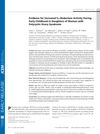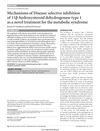Apparent Cortisone Reductase Deficiency: A Rare Cause of Hyperandrogenemia and Hypercortisolism
January 2000
in “
Hormone Research in Paediatrics
”
androgenetic alopecia cortisone reductase deficiency 11β-hydroxysteroid dehydrogenase 11β-HSD1 17-OH-progesterone testosterone adrenal hyperplasia cystic teratomas tetrahydrocortisol tetrahydrocortisone plasma cortisol androgenic hair loss cortisone deficiency 11-beta-HSD1 17-hydroxyprogesterone cortisol
TLDR Cortisone reductase deficiency can cause high androgen and cortisol levels and may be missed in women with similar symptoms.
A 55-year-old woman with androgenetic alopecia and a history of sterility was initially suspected to have 21-hydroxylase deficiency but was later found to have cortisone reductase deficiency, a rare condition affecting hepatic 11β-hydroxysteroid dehydrogenase (11β-HSD1). Despite elevated 17-OH-progesterone and testosterone levels, urinary steroid analysis and abdominal CT revealed bilateral adrenal hyperplasia and ovarian masses, leading to a diagnosis of cystic teratomas. Post-surgery, a decreased tetrahydrocortisol/tetrahydrocortisone ratio and elevated plasma cortisol confirmed cortisone reductase deficiency. This case highlighted the need for awareness of this rare condition in hyperandrogenic women, as it may be overlooked in favor of more common diagnoses.




